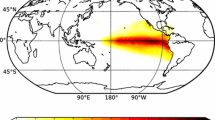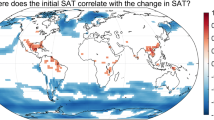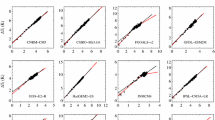Abstract
A land–sea surface warming ratio (or φ) that exceeds unity is a robust feature of both observed and modelled climate change. Interestingly, though climate models have differing values for φ, it remains almost time-invariant for a wide range of twenty-first century climate transient warming scenarios, while varying in simulations of the twentieth century. Here, we present an explanation for time-invariant land–sea warming ratio that applies if three conditions on radiative forcing are met: first, spatial variations in the climate forcing must be sufficiently small that the lower free troposphere warms evenly over land and ocean; second, the temperature response must not be large enough to change the global circulation to zeroth order; third, the temperature response must not be large enough to modify the boundary layer amplification mechanisms that contribute to making φ exceed unity. Projected temperature changes over this century are too small to breach the latter two conditions. Hence, the mechanism appears to show why both twenty-first century and time-invariant CO2 forcing lead to similar values of φ in climate models despite the presence of transient ocean heat uptake, whereas twentieth century forcing—which has a significant spatially confined anthropogenic tropospheric aerosol component that breaches the first condition—leads to modelled values of φ that vary widely amongst models and in time. Our results suggest an explanation for the behaviour of φ when climate is forced by other regionally confined forcing scenarios such as geo-engineered changes to oceanic clouds. Our results show how land–sea contrasts in surface and boundary layer characteristics act in tandem to produce the land–sea surface warming contrast.









Similar content being viewed by others
References
Ackerley D, Booth BBB, Knight SHE, Highwood EJ, Frame DJ, Allen MR, Rowell DP (2011) Sensitivity of twentieth-century sahel rainfall to sulfate aerosol and CO2 forcing. J Clim 24:4999–5014
Andrews T, Forster PM, Gregory JM (2010) A surface energy perspective on climate change. J Clim 22:2557–2570
Bala G, Caldeira K, Nemani R, Cao L, Ban-Weiss G, Shin H-J (2011) Albedo enhancement of marine clouds to counteract global warming: impacts on the hydrological cycle. Clim Dyn 37:915–931. doi:10.1007/s00382-010-0868-1
Banks HT, Gregory JM (2006) Mechanisms of ocean heat uptake in a coupled climate model and the implications for tracer based predictions of ocean heat uptake. Geophys Res Lett 33:L07608. doi:10.1029/2005GL025352
Boucher O, Lohmann O (1995) The sulfate-CCN-cloud albedo effect. Tellus 47:281–300
Budyko MI (1969) The effect of solar radiation variations on the climate of the earth. Tellus 21:611–619
Byrne MP and O’Gorman PA (2013) Land–ocean contrast over a wide range of climates: convective quasi-equilibrium theory and idealized simulations. J Clim (in press)
Cnossen I, Lu H, Bell CJ, Gray LJ, Joshi MM (2011) Solar signal propagation: the role of gravity waves and stratospheric sudden warmings. J Geophys Res 116. doi:10.1029/2010JD014535
Dommenget D, Flöter J (2011) Conceptual understanding of climate change with a globally resolved energy balance model. Clim Dyn 37:2143–2165. doi:10.1007/s00382-011-1026-0
Dong B-W, Gregory JM, Sutton RT (2009) Understanding land–sea warming contrast in response to increasing greenhouse gases. Part I: transient adjustment. J Clim 22:3079–3097
Doutriaux-Boucher M, Webb MJ, Gregory JM, Boucher O (2009) Carbon dioxide induced stomatal closure increases radiative forcing via a rapid reduction in low cloud. Geophys Res Lett 36:L02703. doi:10.1029/2008GL036273
Drost F, Karoly D, Braganza K (2012) Communicating global climate change using simple indices: an update. Clim Dyn 39:989–999
Fasullo JT (2010) Robust land–ocean contrasts in energy and water cycle feedbacks. J Clim 23:4677–4693
Forster PM, De F, Blackburn M, Glover R, Shine KP (2000) An examination of climate sensitivity for idealised climate change experiments in an intermediate general circulation model. Clim Dyn 16:833–849
Forster P, Ramaswamy V, Artaxo P, Berntsen T, Betts R, Fahey DW, Haywood J, Lean J, Lowe DC, Myhre G, Nganga J, Prinn R, Raga G, Schulz M, Van Dorland R (2007) Changes in atmospheric constituents and in radiative forcing. In: Solomon S, Qin D, Manning M, Chen Z, Marquis M, Averyt KB, Tignor M, Miller HL (eds) Climate change 2007: the physical science basis. Contribution of working group I to the fourth assessment report of the intergovernmental panel on climate change. Cambridge University Press, Cambridge, UK and New York, NY, USA
Groisman PY, Karl TR, Knight RW (1994) Observed impact of snow cover on the heat balance and the rise of continental spring temperatures. Science 263:198–200. doi:10.1126/science.263.5144.198
Holton JR (1992) An introduction to dynamic meteorology. Academic press, San Diego
Huntingford C, Cox PM (2000) An analogue model to derive additional climate change scenarios from existing GCM simulations. Clim Dyn 16:575–586
Hwang Y-T, Frierson DMW (2010) Increasing atmospheric poleward energy transport with global warming. Geophys Res Lett 37:L24807. doi:10.1029/2010GL045440
Jones A, Haywood J, Boucher O (2009) Climate impacts of geoengineering marine stratocumulus clouds. J Geophys Res 114:D10106. doi:10.1029/2008JD011450
Joshi MM, Gregory JM (2008) The dependence of the land–sea contrast in surface climate response on the nature of the forcing. Geophys Res Lett 35:L24802. doi:10.1029/2008GL036234
Joshi MM, Gregory JM, Webb MJ, Sexton DMH, Johns TC (2008) Mechanisms for the land–sea warming contrast exhibited by simulations of climate change. Clim Dyn 30:455–465
Kiehl J, Schneider T, Rasch P, Barth M, Wong J (2000) Radiative forcing due to sulfate aerosols from simulations with the national center for atmospheric research community climate model, version 3. J Geophys Res 105:1441–1457
Lambert FH, Allen MR (2009) Are changes in global precipitation constrained by the tropospheric energy budget? J Clim 22:499–517
Lambert FH, Chiang JCH (2007) Control of land–ocean temperature contrast by ocean heat uptake. Geophys Res Lett 34:L13704. doi:10.1029/2007GL029755
Lambert FH, Webb MJ, Joshi MM (2011) The relationship between land–ocean surface temperature contrast and radiative forcing. J Clim 24:3239–3256
Laurian A, Drijfhout SS, Hazeleger W, Van den Hurk B (2010) Response of the Western European climate to a collapse of the thermohaline circulation. Clim Dyn 34:689–697. doi:10.1007/s00382-008-0513-4
Lohmann U, Feichter J (2005) Global indirect aerosol effects: a review. Atmos Chem Phys 5:715–737
Lu J, Cai M (2010) Quantifying contributions to polar warming amplification in an idealized coupled general circulation model. Clim Dyn 34:669–687
Manabe S, Stouffer RJ, Spelman MJ, Bryan K (1991) Transient responses of a coupled ocean-atmosphere model to gradual changes of atmospheric CO2 part I: annual mean response. J Clim 4:785–818
Martin GM, Bellouin N, Collins WJ, Culverwell ID, Halloran PR, Hardiman SC, Hinton TJ, Jones CD, McDonald RE, McLaren AJ, O’Connor FM, Roberts MJ, Rodriguez JM, Woodward S, Best MJ, Brooks ME, Brown AR, Butchart N, Dearden C, Derbyshire SH, Dharssi I, Doutriaux-Boucher M, Edwards JM, Falloon PD, Gedney N, Gray LJ, Hewitt HT, Hobson M, Huddleston MR, Hughes J, Ineson S, Ingram WJ, James PM, Johns TC, Johnson CE, Jones A, Jones CP, Joshi MM, Keen AB, Liddicoat S, Lock AP, Maidens AV, Manners JC, Milton SF, Rae JGL, Ridley JK, Sellar A, Senior CA, Totterdell IJ, Verhoef A, Vidale PL, Wiltshire A (2011) The HadGEM2 family of met office unified model climate configurations. Geosci Model Dev 4:723–757
Meehl GA, Stocker TF, Collins WD, Friedlingstein P, Gaye AT, Gregory JM, Kitoh A, Knutti R, Murphy JM, Noda A, Raper SCP, Watterson IG, Weaver AG, Zhao Z-C (2007) Global climate projections. In: Solomon S, Qin D, Manning M, Chen Z, Marquis M, Averyt KB, Tignor M, Miller HL (eds) Climate change 2007: the physical science basis. Contribution of working group I to the fourth assessment report of the intergovernmental panel on climate change. Cambridge University Press, Cambridge, UK and New York, NY, USA
Mitchell JFB, Johns TC (1997) On modification of global warming by sulfate aerosols. J Clim 10:245–267
North GR (1975) Theory of energy-balance climate models. J Atmos Sci 32:2033–2043
North GR, Cahalan RF, Coakley JA Jr (1981) Energy balance climate models. Rev Geophys Space Phys 19:91–121
Raper SCB, Gregory JM, Stouffer RJ (2002) The role of climate sensitivity and ocean heat uptake on AOGCM transient temperature response. J Clim 15:124–130
Reddy K, Pant P, Phanikumar DV, Dumka UC, Kumar YB, Singh N, Joshi H (2011) Radiative effects of elevated aerosol layer in Central Himalayas. Int J Remote Sens 32:9721–9734
Rowell DP, Jones RG (2006) Causes and uncertainty of future summer drying over Europe. Clim Dyn 27:281–299. doi:10.1007/s00382-006-0125-9
Shindell D, Faluvegi G (2009) Climate response to regional radiative forcing during the twentieth century. Nat Geosci 2:294–300
Shindell D, Schulz M, Ming Y, Takemura T, Faluvegi G, Ramaswamy V (2010) Spatial scales of climate response to inhomogeneous radiative forcing. J Geophys Res 115:D19110. doi:10.1029/2010JD014108
Sutton RT, Dong B-W, Gregory JM (2007) Land–sea warming ratio in response to climate change: IPCC AR4 model results and comparison with observations. Geophys Res Lett 34:L02701. doi:10.1029/2006GL028164
Taylor KE, Stouffer RJ, Meehl GA (2012) An overview of CMIP5 and the experiment design. Bull Am Meteor Soc 93:485–498. doi:10.1175/BAMS-D-11-00094.1
Weaver AJ, Eby M, Wiebe EC, Bitz CM, Duffy PB, Ewen TL, Fanning AF, Holland MM, MacFadyen A, Matthews HD, Meissner KJ, Saenko O, Schmittner A, Wang H, Yoshimori M (2001) The UVic earth system climate model: model description, climatology and application to past, present and future climates. Atmos Ocean 39:361–428
Williams KD, Jones A, Roberts DL, Senior CA, Woodage MJ (2000) The response of the climate system to the indirect effects of anthropogenic aerosol. Clim Dyn 17:845–856
Willis JK, Roemmich D, Cornuelle B (2004) Interannual variability in upper ocean heat content, temperature, and thermosteric expansion on global scales. J Geophys Res 109:C12036. doi:10.1029/2003JC002260
Yoshimori M, Broccoli AJ (2008) Equilibrium response of an atmosphere-mixed layer ocean model to different radiative forcing agents: global and zonal mean response. J Clim 21:4399–4423. doi:10.1175/2008JCLI2172.1
Acknowledgments
Manoj Joshi was supported by the UK National Centres for Atmospheric Science (Climate). Mark Webb was supported by the Joint DECC/Defra Met Office Hadley Centre Climate Programme (GA01101). We acknowledge Jonathan Gregory for very useful discussions, Yoko Tsushima for providing the HadGEM2 integration and diagnostics, and David Long and Joe Osborne for providing processed CMIP5 data. We would like to thank the reviewers of this manuscript for very useful suggestions. We acknowledge the World Climate Research Programme’s Working Group on Coupled Modelling, which is responsible for CMIP, and we thank the climate modeling groups (listed in Table 2 of this paper) for producing and making available their model output. For CMIP the U.S. Department of Energy’s Program for Climate Model Diagnosis and Intercomparison provides coordinating support and led development of software infrastructure in partnership with the Global Organization for Earth System Science Portals.
Author information
Authors and Affiliations
Corresponding author
Rights and permissions
About this article
Cite this article
Joshi, M.M., Lambert, F.H. & Webb, M.J. An explanation for the difference between twentieth and twenty-first century land–sea warming ratio in climate models. Clim Dyn 41, 1853–1869 (2013). https://doi.org/10.1007/s00382-013-1664-5
Received:
Accepted:
Published:
Issue Date:
DOI: https://doi.org/10.1007/s00382-013-1664-5




